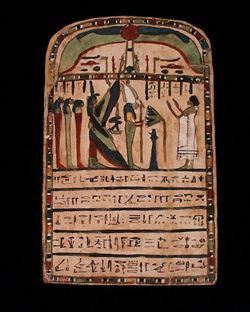
The Egyptians believed that life after death would be a continuation of earthly life. This meant that food, drink and all kinds of objects used during life on earth would be needed. Thus all kinds of things were put into the tombs. In addition, they hoped that in the future, offerings of food and drink would continue to be brought to the tomb. Some Egyptians drew up contracts with mortuary priests or temples to ensure this. They also called upon future visitors to the necropolis. Texts on stelae and tomb walls sketch the good life that the owner had led, something worthy of reward. They made promises to try to persuade the visitor to make an offering. "It will not cost you anything", "it will do you more good than me", are regularly recurring phrases. They tried to attract attention with unusual formulations or ways of writing. If all this effort did not result in offerings, then there were always the representations of food (just as useful in Egyptian eyes) in the tomb in the form of offering lists, imitation food and models of houses, granaries, bakeries, breweries and such like. Shabtis, too, statuettes which would perform work for the deceased in the hereafter, were designed to make life after death more comfortable. All of these measures were intended to ensure the deceased an afterlife which was at least the equal of that on earth. In order to make living on in the afterlife possible, the Egyptians thought that it was also necessary to preserve the body. Essential for this were a sarcophagus to protect the body and a stela bearing the name of the deceased, in order to preserve his identity. Further, certain rituals had to be performed for the deceased in order to make him an akh. Naturally, in the underworld there were also many dangers. The deceased was provided with many texts designed to dispel or overcome these dangers. In the Old Kingdom these were still texts for the king alone (the Pyramid Texts), but from the Middle Kingdom on increasingly large groups of people had access to this knowledge (Coffin Texts, Book of the Dead). These funerary texts created a picture of what people imagined life "yonder" to be like. Some sarcophagi are inscribed with complete maps of the underworld. The Amduat, one of the books of the underworld dating to the New Kingdom and painted in various tombs in the Valley of the Kings, gives detailed sketches of the other world, including its dimensions. The central idea in all of this was the desire to be assimilated with Osiris, something that originally only applied to the king. Thus every deceased person in the texts is referred to as the "Osiris so-and-so".